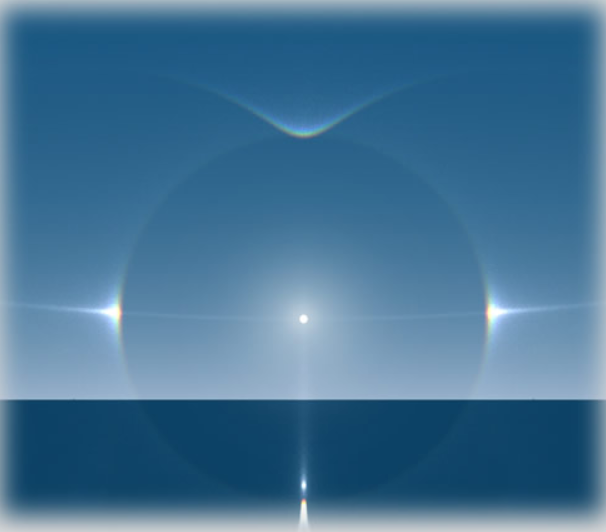Atmospheric Halos
Atmospheric Halos: A Mesmerizing Display of Nature's Artistry
Atmospheric halos are a captivating phenomenon that grace our skies with their delicate beauty. These mesmerizing displays, ranging from simple circles around the sun or moon to intricate webs of arcs spanning the entire sky, are created by the interaction of light with tiny ice crystals suspended in the atmosphere. In this article, we will delve into the formation of halos, explore when and where they can be seen, and even provide a way for you to create your own halo displays.
Understanding the Formation of Halos
Halos are formed when light encounters ice crystals in the atmosphere, causing refraction and reflection. The unique geometric properties of these ice crystals play a crucial role in shaping the appearance of halos. As light passes through these crystals, it is bent and redirected, resulting in the formation of various optical phenomena.
Unraveling the Secrets of Crystal Inhabitants
By observing halos, we gain valuable insights into the properties of the ice crystals inhabiting the clouds. The intricate patterns and arrangements of halos provide clues about the shape, size, and orientation of these crystals. Scientists study these patterns to better understand atmospheric conditions and improve our knowledge of crystal formation processes.
Exploring Different Types of Halos
Halos come in a diverse range of forms, each with its own unique characteristics. Some of the most commonly observed halos include:
-
22° Halo: This circular halo surrounds the sun or moon when they are relatively low in the sky. It is caused by the refraction and reflection of light by hexagonal ice crystals.
-
Sundogs: Also known as parhelia, sundogs are bright spots that appear on either side of the sun. They are formed when sunlight passes through horizontally oriented ice crystals.
-
Upper Tangent Arc: This arc can be seen above the 22° halo and is caused by the refraction of light through column-shaped ice crystals.
-
Sun Pillar: A vertical shaft of light extending above or below the sun, sun pillars are formed when sunlight reflects off the surfaces of ice crystals.
When and Where to Witness the Splendor
To witness the enchanting beauty of halos, certain conditions need to be met. Firstly, the presence of ice crystals in the atmosphere is essential. These crystals can be found in high-altitude clouds, such as cirrus clouds, which are composed of tiny ice particles. Additionally, the angle of the sun or moon plays a crucial role in halo visibility. Halos are more commonly observed when the sun or moon is relatively low in the sky, as the light has a longer path to travel through the atmosphere, increasing the chances of interaction with ice crystals.
The occurrence of halos is not limited to specific geographic locations. However, regions with colder climates and frequent cloud cover tend to offer more opportunities for halo sightings. It is worth noting that halo displays are relatively rare compared to other atmospheric optical phenomena, adding to their allure and sense of wonder.
HaloSim: Unleash Your Creativity
For those fascinated by halos and eager to explore their intricate forms, there is an exciting way to create your own halo displays. HaloSim, a full-color simulator program, allows you to experiment with different parameters and visualize the formation of halos. By adjusting variables such as crystal shape, size, and orientation, you can observe how these factors influence the appearance of halos. This interactive tool provides a unique opportunity to delve into the science behind these captivating optical phenomena and unleash your creativity in crafting your own virtual halo displays.
In conclusion, atmospheric halos are a testament to nature's artistry and the interplay between light and ice crystals. Their delicate beauty enchants observers worldwide, while also providing valuable insights into the properties of ice crystals in our atmosphere. By understanding the formation of halos, exploring different types, and knowing when and where to look, you can enhance your appreciation for these awe-inspiring displays. And with the help of HaloSim, you can embark on a journey of discovery, creating your own virtual halo masterpieces. So, keep your eyes on the sky, for you never know when nature will unveil its next stunning halo spectacle.
Ice halo displays range from the familiar circle around the sun or moon to rare and prized events when the whole sky is webbed by intricate arcs.
Tiny ice crystals in the atmosphere create halos by refracting and reflecting light.
Halos bestow a delicate beauty to the skies and tell us about the crystals inhabiting the clouds.
Find out how halos are formed, when and where to see them in the skies.
Create your own halo displays by downloading the full colour simulator program, HaloSim.

A circular 22° halo surrounds a low sun. To the left and right are sundogs. Above shines an upper tangent arc and beneath is a sun pillar. HaloSim simulation of halos frequently visible in the sky.
Note: this article has been automatically converted from the old site and may not appear as intended. You can find the original article here.
Reference Atmospheric Optics
If you use any of the definitions, information, or data presented on Atmospheric Optics, please copy the link or reference below to properly credit us as the reference source. Thank you!
-
<a href="https://atoptics.co.uk/blog/atmospheric-halos/">Atmospheric Halos</a>
-
"Atmospheric Halos". Atmospheric Optics. Accessed on July 27, 2024. https://atoptics.co.uk/blog/atmospheric-halos/.
-
"Atmospheric Halos". Atmospheric Optics, https://atoptics.co.uk/blog/atmospheric-halos/. Accessed 27 July, 2024
-
Atmospheric Halos. Atmospheric Optics. Retrieved from https://atoptics.co.uk/blog/atmospheric-halos/.